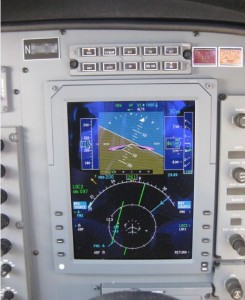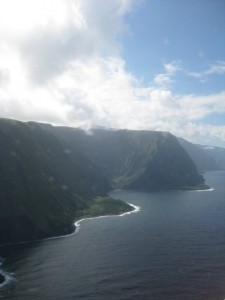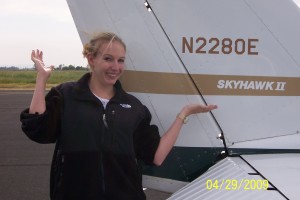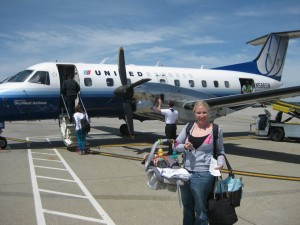Learning to Fly
The following is a guest post from Michelle from ThirtySixThousand.com.
I’ve been flying for as long as I can remember. I made 4 trips to Hawaii before I was a year old and that trend has continued ever since. My family owns a small business over in the islands, but California is my home. My unconventional “commute” to work involves taking a transpacific flight at least every few months. My dad is also commercial pilot (both helicopter and airplane) and much of my early childhood was spent in the back of whatever aircraft he was flying at the time. To be honest, when I was younger I was never that interested in aviation as a career. I just loved to travel and I loved to go flying but had little interest in becoming a pilot myself. It wasn’t until years later that things changed.
Fast forward to a few years out of business school and there I was sitting and people-watching (as I often do) during a long layover at Phoenix’s Sky Harbor Airport. I was on my way to Hawaii to go to work. It seemed that most of the people that day were business travelers, and none of them seemed very happy to be there. I then noticed a group of pilots in uniform. They were smiling as they casually strolled through the terminal. They were getting paid to be at the airport, paid to fly, and best of all when they got to their destination they were off work and free to play. It seemed like a better deal.
As a frequent flier I’d always been curious about little things when I flew, like what all the different runway markings meant, or what was going on while listening to ATC on Channel 9. It was that curiosity that led me to sign up for aviation ground school at my local community college, which as it turned out would be the first step towards me becoming a pilot myself. I did well in the class and decided to take the FAA written exam, just for fun, which I easily passed with a score of 95. It wasn’t until after that when I decided to go for an intro-flight at a nearby airport and got to take the controls of an aircraft for the first time. I was hooked.
I did most of my flight training at LHM (Lincoln Regional Airport) near Sacramento in a Cessna 172 (I also flew in a 150, but I’d rather forget about that). My first cross country solo was to Chico and Stockton. I also got to fly to Sacramento International (SMF), which, after having flown there so many times commercially, was absolutely exhilarating when I got to show up there in my own plane. I remember the first time I was cleared to land on 16L, the tower had a Southwest 737 hold short for me. After landing, I turned off on the taxiway and looked over to see all the people through the windows of the relatively massive plane, and a few were even looking back at me. I felt pretty cool. Another highlight of my training was taking a lesson when I was over on Maui. We flew along the world famous sea cliffs on the north shore of Molokai, landed at Kalaupapa, and then on approach back into runway 2 at Kahului (OGG), I got to follow a C-130, which has got to be one of my all-time favorite planes. It was awesome.
Getting my private pilot’s license was one of the most challenging but at the same time one of the most fun and rewarding things I’ve ever done. There is a lot of studying involved and compared to business school, flying isn’t really something you can b.s. your way through. It is both mentally and physically demanding. Throughout the process there is a huge emphasis put on safety; you train for every possible scenario (engine loss, fire, etc.), and because of that, it is no surprise that flying is actually one of the safest activities out there. There’s a joke that goes something like “the most dangerous part of flying is driving to the airport”, but it’s not really a joke, it’s kind of true. I’m also sure some of you have heard the statistic that more people are killed annually by donkeys than by plane crashes; I have no idea how they even measure that, but given a choice, I’d choose airplane over donkey any day!
People are always curious and ask about any times when I was scared during my training. To be honest I’ve been way more scared as a passenger on a commercial flight than I ever was flying on my own. Believe it or not my closest call was with an animal, not aircraft. I did have a controller give me an instruction once that took me a little close to another plane in the pattern, but that didn’t startle me half as much as the time a coyote darted out in front of my plane on the taxiway at SCK. I was there on my solo, and I have to admit, maybe that was something we didn’t train for! I reported it to the tower, and they said they’d have it “taken care of”, whatever that means. In case you were wondering where your last airline meal came from…I’m just kidding. Anyway stuff like that is extremely rare, and if nothing else after going through the training I even feel more safe even as a passenger. I have a better understanding of the system and how much hard work and experience it takes to become a pilot.
The FAA minimum required number of hours for the private license is 40. All said and done, I had about 80 hours when I went for my check-ride. Time and costs vary by location, flight school, and how long it takes you to complete your training, but expect to spend AT LEAST $5,000 or $6,000 and a few months for a private license. I flew a few times a week over a 9 month period, and all said and done my flight training cost about $10,000. There are accelerated programs out there that claim to get you your license in a month and under $5,000. The curriculum however doesn’t change; there is a lot to learn in a short time, so it’s really up to you if you want to spread it out (which can also help distribute the cost) or try to “drink out of a firehouse” as I’ve heard it described, taking in as much as you can to get it over with. Either way, there are 3 parts to getting your license: the written exam, an oral exam, and the practical flight (aka check ride).
Once you get your pilot license, it’s good for life. In order to stay “current”, you need a valid medical certificate and to complete flight review with an instructor every 24 months or go for a more advanced rating or certificate, but the license itself never expires. My last flight as a pilot, sad to say, was all the way back in 2009 when I passed my private pilot check ride. Since then I completed instrument ground school (the next step) and passed the written exam for that. About a year ago I got the chance to fly in the right seat with one of my dad’s friend’s in a Citation CJ1 which is about as close to flying an airliner as I can imagine. Normally this would be off limits to someone without an instrument rating as any flights above 18,000 feet are IFR (Instrument Flight Rules), but my dad’s friend is in an ATP (airline transport pilot) and the aircraft was certified for single pilot operation. Technically, I was just along for the ride (and it was an awesome ride), but I did get to handle a few of the announcements and play around with the FMS (Flight Management System). I also just recently got another job- I’m now a mom to an incredible little boy and young jet setter (at 8 months he’s already been to Hawaii twice). I’m still flying about once a month, but as a passenger mostly on United Airlines, where I hope to soon become a Million Miler. No matter what, I just love to fly. I still haven’t given up on my dream of one day becoming a professional pilot, but at the moment things are on hold. Getting a commercial license takes at least 250 hours of flight time, and costs about $50,000, neither of which I have at the moment, but I would consider that any day in lieu of going back to business grad school!
For anyone out there interested in getting a private pilot’s license or just interested in learning more, I’d highly recommend going to aviation ground school or taking an intro flight. A lot of community colleges offer ground school for cheap (I want to say mine was only a couple hundred dollars including all course materials and the FAA written exam), and if you actually want to get your hands on the controls of a plane, an intro flight typically runs about $75-$100 for one hour . Check around your local airport for more information and to find a flight school. If you’re the curious type like me and like to read, I recommend picking up a copy of the Jeppesen Private Pilot textbook. They can sometimes be found on ebay for as little as $20 for past editions, and it will tell you probably everything you’ve ever wanted to know about flying. If you don’t like to read, the book has lots of great pictures and excellent diagrams and you still should get it! The Airplane Flying Handbook published by the FAA is another good one. There isn’t a day that goes by when I don’t think about flying, and I look forward to getting back into it as soon as I can. Until then, I’ll always be grateful for the wonderful experience I had and if nothing else every time I step foot on a commercial airliner these days, I always get a smile out of remembering something cool I learned back in aviation ground school.
Glass Panel on the Citation CJ1
View of Molokai’s North Shore (Hawaii) while I was flying a C172
![The image is of a United States of America Federal Aviation Administration (FAA) pilot certificate. The certificate includes the following details:
- Title: "UNITED STATES OF AMERICA"
- Issuing Authority: "DEPARTMENT OF TRANSPORTATION - FEDERAL AVIATION ADMINISTRATION"
- Name: "MICHELLE [REDACTED] SINGH"
- Address: [REDACTED]
- Nationality: "USA"
- Date of Birth: "10 FEB"
- Sex: "F"
- Height: "67"
- Weight: "140"
- Hair: "BLOND"
- Eyes: "GREEN"
- Certificate Type: "PRIVATE PILOT"
- Certificate Number: [REDACTED]
- Date of Issue: "29 APR 2009"
- Signature of the Administrator
- A holographic seal and a background image of an aircraft and a pilot.
(Note: Personal information has been redacted for privacy.)](https://theskepticaltraveler.boardingarea.com/wp-content/uploads/2012/10/license-300x194.jpg)

